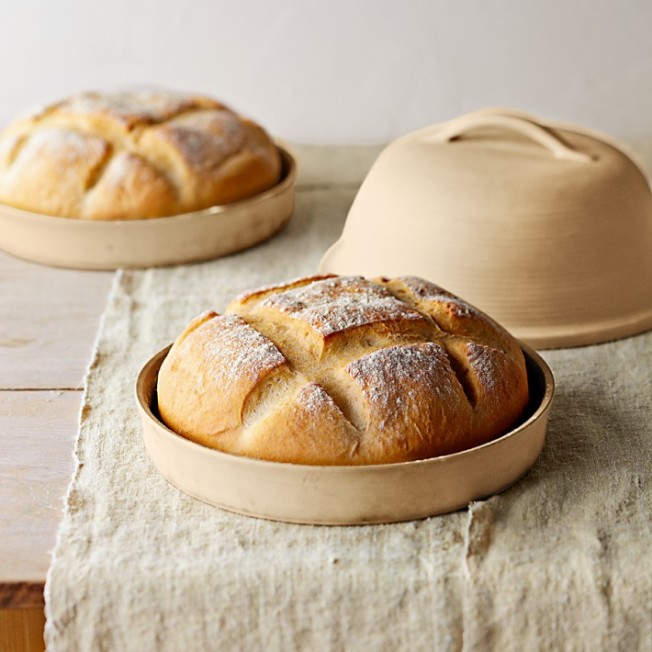Cold winter weekends are the perfect excuse to cozy up inside with a baking project. This one will make your kitchen smell like heaven: a country-style loaf of bread baked in a stoneware cloche, with a golden brown crust and a tender crumb. The time-tested recipe comes from our founder, Chuck Williams, who fell in love with the rustic country loaves he first tried in France and Italy. The secret is in the cloche: it duplicates the even, intense heat produced by a brick-lined oven.
Crusty Country Loaf
1 package active dry yeast
1 tsp. sugar
1 3/4 cups warm water (110°F), plus more as needed
5 cups (1 lb. 9 oz.) country French, rustic wheat or all-purpose flour, plus more as needed
1 Tbs. salt
Cornmeal for sprinkling
In a small bowl, dissolve the yeast and sugar in 1/4 cup of the warm water and let stand until bubbly, 5 to 10 minutes.
In the bowl of an electric mixer fitted with the dough hook, combine the 5 cups flour and the salt and beat on low speed for 30 seconds. Add the yeast mixture and the remaining 1 1/2 cups water and beat until thoroughly combined, 6 to 8 minutes, adding more water or flour if needed. Turn the dough out onto a floured work surface and knead until soft, silky and elastic.
Spray the inside of the mixer bowl with nonstick cooking spray and return the dough to the bowl. Cover with plastic wrap and let rise in a warm place until doubled in size, 45 to 60 minutes. Punch down the dough and transfer to a work surface. Knead the dough a few times. Let the dough rest for 5 minutes, then shape into a ball.
Sprinkle the base of a round bread cloche with cornmeal and place the ball of dough in the center. Cover with the lid and let rise in a warm place until doubled in size, 45 to 60 minutes.
Preheat an oven to 450°F.
Using a sharp knife, cut several slashes on top of the loaf. Cover the cloche, transfer to the oven and bake for 15 minutes. Reduce the oven temperature to 400°F and continue baking until the bread is crusty, golden brown and sounds hollow when tapped, 30 to 40 minutes more, removing the lid during the last 5 to 10 minutes of baking. Transfer the loaf to a wire rack and serve while still warm. Makes 1 loaf.


14 comments
its alright
I was very pleased with the way this bread came out but even though it was cooked to perfection with a great texture and nice crusty outside it lacked taste. Without butter my bread had little no taste even though it had a nice yeasty aroma. How can I adjust it to taste better.
Made this today in my dutch oven. It turned out perfectly. Thanks for this wonderful recipe!
Is it possible to make this recipe with some sour dough flavor, and if so, how would the ingredients be adjusted to accommodate a “seasoned” starter? If not a good idea, how about a recipe link to a very good strong sour dough bread.
Hi Scarlet, we haven’t tested the recipe this way, so we can’t say for sure. Here’s a link to a sourdough bread recipe featuring a starter: https://www.williams-sonoma.com/recipe/crusty-sourdough-bread.html
Hope this helps — enjoy!
This was my first time making bread completely from scratch. I followed the recipe as written and the bread turned out great. It even looked like the picture! 🙂 I don’t have a cloche but had some clay vessels from a Pampered Chef party purchase from a decade ago (which I think is essentially the same thing). This was very easy. I’ll try this again but using less salt and more sugar for a sweeter bread as one reader suggested.
I love bread!
Directions are to preheat oven to 450 degrees. Do we preheat the Dutch oven to 450 degrees or 400?
Hi Kate31, we would recommend preheating the Dutch oven to 450 degrees. Good luck!
What makes the cloche more effective than, for example, using a LeCruset Dutch oven?
Should the cloche [or dutch oven, if possible to use instead] be preheated to a warm temperature, say 200 degrees, before placing the dough inside to rise?
Hi Lisa, a cloche generally does not need to be preheated, but a Dutch oven (or any cast iron) does.
Hi Jill, we passed your question along to our W-S Test Kitchen cooks, and here’s what they had to say:
Both a cloche and a Dutch oven can be used to trap steam and create crusty breads. In general, the Dutch oven tends to produce a heavier/denser bread while a cloche produces one that’s a little lighter. Also, a cloche does not have to be preheated before baking. You can also proof dough directly in the cloche itself.
Hope this helps!
Thanks!